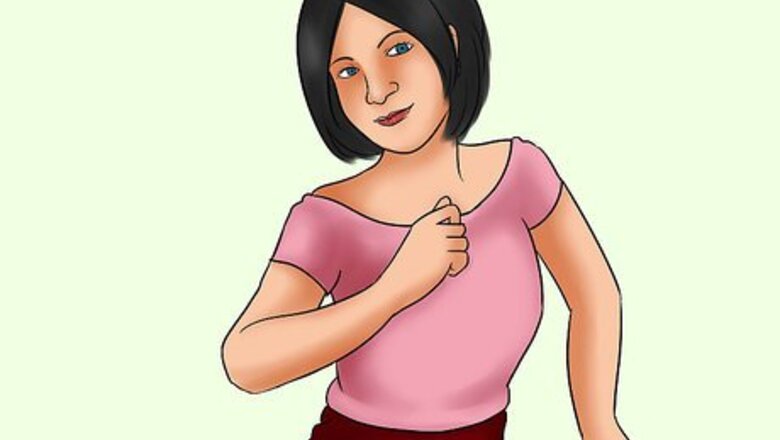
views
Learning Basic Bachata on Your Own
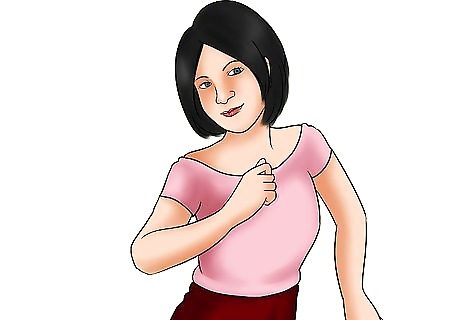
Feel the beat. Bachata is an 8-beat dance (like the Salsa). Bachata music has four beats per measure. At its most basic, bachata has dancers move left for one four-beat measure, then right for the next. Listen to the music and try to find the pulsing beat. Modern electronic bachata music usually has some form of synth percussion hitting every beat, which makes the beat easy to find. Traditional bachata music can have slightly more complex percussion, but usually still have beats that are easy to "feel". Here's an example of how you'll count your steps during a basic bachata: (Stepping to the left) 1, 2, 3, (4), (stepping to the right) 5, 6, 7, (8), (stepping to the left) 1, 2, 3, (4), etc.. The 4th and 8th beats are marked in parentheses because these beats are often counted silently. In terms of modern "pop" bachata, you might want to check out the work of modern Latino artists like Prince Royce, Anthony Santos, Aventura, Don Omar, and Maite Perroni. These artists are influenced by bachata and many record songs in modernized bachata style. Try starting with "Creiste" by Anthony Santos. Older, more traditional bachata artists may be slightly more obscure today, owing to the popularity of their "pop" counterparts. Try checking out artists like Yoskar Sarante, Frank Reyes, and Joe Veras. The song "Intentalo Tu" by Joe Veras is a great bachata tune with a semi-traditional flavor. However, the best option is to have a personal teacher who can teach you in a learning style that is most suitable for you.

Step to the left. Begin with both your feet together. Count the beat of the music: 1, 2, 3, 4, 1, 2, 3, 4. When you're ready, start by stepping to the left with your left foot on beat 1. Then, bring your right foot to your left foot on beat 2. Step left with your left foot again on beat 3, then finally, raise your right foot off the ground slightly on beat 4.
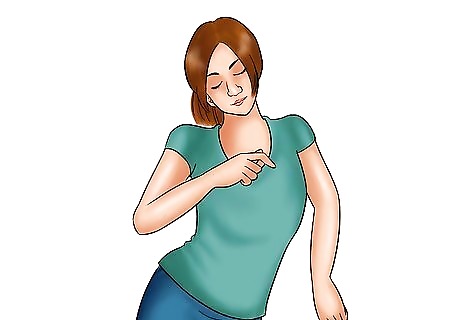
Notice the motion in your hips. You may have noticed that by raising your right foot off the ground slightly, you were forced to jut your hips out to the right. This is perfect - eventually, the effect you want to create is that of a continuous, rolling motion in your hips. As you continue to dance, be conscious of the motion of your hips.

Repeat your steps in the opposite direction. Don't stop! Plant your right foot on the ground on the next beat 1, stepping to the right. Then, just mirror the motions you've already made in the opposite direction: bring your left foot to your right on beat 2, step right on beat 3, and raise your left foot slightly on 4. Your hips should jut to the left now.

Keep time and repeat. Practice these basic steps until you think you have a sense for the basic pulse of bachata. As you dance, keep your knees slightly bent (obviously bending your knee more when you raise your foot) and try to keep a slight rhythmic swaying motion in your hips. In bachata, as with many forms of Latin dance, the swaying motion in the hips is typically more pronounced in the female partner than in the male partner. If you think this is too simple, don't worry - the bachata is about to get much more interesting.
Incorporating a Partner

Ask your partner to dance. Knowing how to graciously accept either a "yes" or a "no" is essential for avoiding awkwardness at clubs, parties, Quinceañeras, and other places where you may want to do the bachata. In traditional bachata, men ask women to dance. However, it's perfectly acceptable for women to do the asking, and for people of the same gender to dance with each other. Gentlemen - when you want to dance with someone, be direct, yet courteous. Approach your potential partner directly, offer them your hand (palm up) and say something short and to-the-point along the lines of "Hey, would you like to dance?" If the person accepts, great! Take her hand and move to the dance floor. If, for any reason, they don't want to, politely acquiesce with a short acknowledgement like "Oh, okay. No problem," then move on. Ladies - when you're asked to dance, reply graciously but honestly. If you do want to dance, simply say "I'd love to", then take your partner's hand and proceed to the dance floor. If you don't, decline politely, briefly and honestly explaining why you'd rather not. For instance, you might say something like, "Oh, I wish I could, but my heels are killing me."
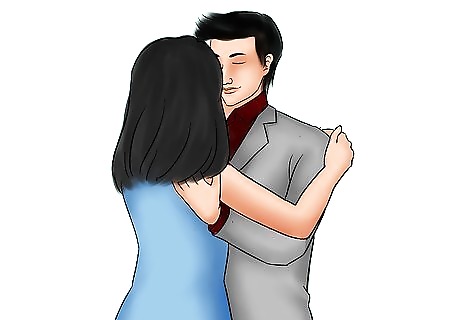
Hold your partner. In Bachata, there are two basic positions for holding your partner - open position and closed position. Open position puts more space between the two partners, as they make contact only through their hands. Open position allows more space and flexibility when it comes to advanced moves like turns. Closed position, on the other hand, is somewhat more intimate, as it involves an arm draped across the lady's back and slight-to-strong contact between the two partners' bodies. Closed position is more common in modern clubs and dance halls owing to cramped floor space. See below for instructions on both positions: Gentlemen: For open position, keep your arms loose and relaxed. Offer your lady partner both palms, facing up. She'll gently place her hands in yours - allow them to rest there. Don't grab with your thumbs. Both your and your partners' elbows should be bent at your sides, which will put your bodies about a foot or two apart. For closed position, wrap your arm around your lady's body so that your palm is resting roughly in the middle of her back. She will drape her arm over yours, resting her hand near your shoulder. Using your unoccupied arm (which is called your "leading arm"), hold her other hand out to the side at about shoulder or chest height, keeping both of your elbows bent. Don't interlock fingers - your hands should be held palm-on-palm, with the back of your hand facing out. As you dance, use your outstretched hand to lead your partner, gently guiding her upper body in the direction you're moving. Ladies: For open position, keep your arms loose and relaxed. Lay your hands palms-down in your partner's. Remember to keep your elbows bent to allow flexibility and ensure you're somewhat close to your partner. For closed position, when your partner wraps his arm around your back, lay your arm over his and rest it near his shoulder. Allow your partner to hold your other hand - the back of your hand should be facing towards you, while the back of his should be facing out. Keep your elbows bent and remember to keep a palm-palm hand hold (don't interlock fingers).

Step with your partner. Practice simply moving in time to the music with your partner. You may find that coordinating your movements so that you both step on the beat is harder than you first thought! Regardless of whether you're in open or closed position, both partners perform basically the same "left four beats, right four beats" motion described above. However, realize that, since both partners are facing each other, one partner will be stepping in the opposite direction as described. Traditionally, in bachata, the man leads, so, if you're a lady, you can just follow in the direction of his motion, whether that means stepping to the right or to the left first.
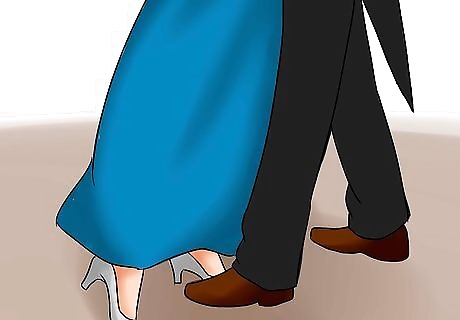
Incorporate back-and-forth motion. As your bachata skill improves and you begin dancing with partners, you'll want to move away from the basic left-and-right bachata steps and towards a more advanced, versatile step pattern that uses back-and-forth movements as well. These back and forth movements are done almost identically to the left-and-right movements - in other words, you'll step forward three beats and pop your hips on beat four, then step backward 3 beats and pop your hips on beat four, lather, rinse, and repeat. As the leading partner steps forward, the following partner steps back with the corresponding foot. For beginners, try moving through the basic left-and-right bachata steps twice, then doing a back-and-forth motion twice, then switching back to the left-and-right motion and repeating. Your steps should be as follows: (To the left) 1, 2, 3, (4) (To the right) 1, 2, 3, (4), (To the left) 1, 2, 3, (4) (To the right) 1, 2, 3, (4) (To the front) 1, 2, 3, (4), (To the back) 1, 2, 3, (4), (To the front) 1, 2, 3, (4), (To the back) 1, 2, 3, (4) (To the left) 1, 2, 3, (4), (To the right)... and so on. Note - because, in traditional bachata, the male partner leads, the (to the front) direction refers to his point of view. The female (or following) partner will step back as the leading partner steps forward, and vice versa.

Add turns. One of the most essential partner moves done in bachata is the turn. In the most basic variation of this move, the male partner raises his arm, allowing the woman to complete a full turn in time to the music, then both partners return to normal dancing without missing a beat. Follow the instructions below to do a basic turn: Gentlemen - As you dance, mentally count out the beat (1, 2, 3, 4). On beat 4, begin to raise your leading arm over your partner's head and begin to release your other arm's grip (as a reminder, in closed position, the leading arm is the outstretched one, rather than the one wrapped around your partner's back). On beat 1 of the next measure, your partner will begin to turn in a circle under your arm, gently holding on to your leading arm as she does so. She will finish turning on beat 3 so that on beat 4 you'll both be dancing in sync again and you'll be able to move together in the opposite direction on the next beat 1. Ladies - feel your partner's leading arm begin to rise on beat 4. Keep holding onto your partner's leading arm, but release your grip on your partner's shoulder with your other arm and move under the curve of his leading arm. On beat 1, start to turn in a circle under his leading arm. Try to finish turning on beat 3 so that you can hit beat 4 in the "normal" dancing position and step together in the opposite direction on beat 1.
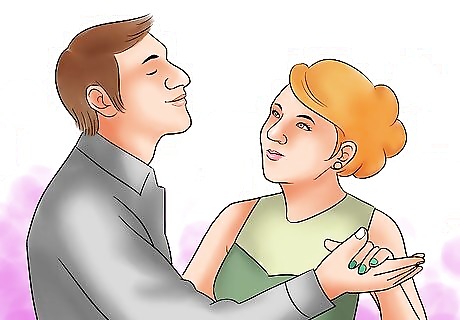
Pay attention to your partner. Above all else, bachata is supposed to be a way for two people to have fun. Both men and women should try to give their partner their full attention. At the simplest level, this means looking at your partner while you dance, not at the floor (and especially not at other people you'd like to dance with). However, this also applies to the way you dance: Pay attention to your partner's movements. if you're leading, make sure your partner is keeping up with you. If you're following, try to match your partner's directions and predict which way he'll go next. When your partner does a glamorous move like a spin or a turn, give your partner the attention s/he deserves. Generally, unless you're doing a special synchronized two-person move, you shouldn't do your own moves while your partner is doing his or hers.
Spicing It Up

Get your whole body in motion. Bachata shouldn't be a dreary shuffle - it should be an upbeat, energetic dance. As your bachata skill grows, try to incorporate more of your body into your basic step patterns. For instance, rather that keeping your upper body mostly straight, try moving your arms in a pumping motion and twisting slightly as you move. Try bending your knees and popping your hips more than you normally would for a low, sensual swaying motion. Eventually, when you're comfortable, the bachata should naturally become a whole-body activity.
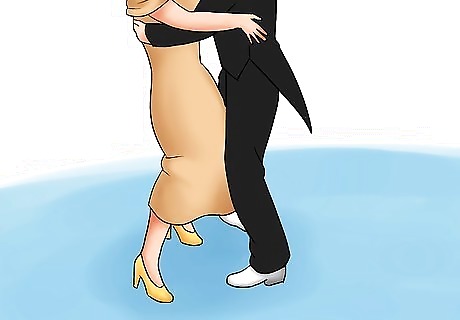
Add bachata urbana flavor. At most modern dance clubs, you'll encounter a casual, modernized version of bachata, rather than the formal, traditional version. This version of the dance, called "bachata urbana", incorporates a wide variety of added moves and minor variations to give bachata an updated, modern feel. Below are instructions for two bachata urbana moves that can give your dance routine some modern flair. The slide - This move is usually performed when you would normally be stepping in the opposite direction as the leading arm (typically, this arm is the leading partner's left arm, so this means you'll do this move when you'd normally step to his right). To do this move, mentally count the beat of the music (1, 2, 3, 4). On beat 4 of the "to the left" measure, the leading partner raises his leading arm so that his hand and his partner's are above their heads. On beat 1 of the "to the right measure," he drops his leading hand to below the waist, takes a big step back with his rear leg, and slides backward until beat 4. The following partner mirrors his movements. The male turn - This move allows the leading male partner to enjoy a flashy turn for a change. The male turn works especially well right after a traditional female turn, so we'll assume you've just "caught" your turning partner on beat 4. On beat 1, start to turn in front of your partner - she doesn't need to raise her hand over you like you would while she's turning. As you turn, she should keep her elbows bent and her hands out in front of her. This way, as you turn, you can grab her non-leading arm with your leading arm so that, for a brief moment, you're both holding hands and facing the same way with your back to her front. Continue turning and "catch" her hands as you normally would on beat 3 so that on beat 4 you're dancing in sync again.
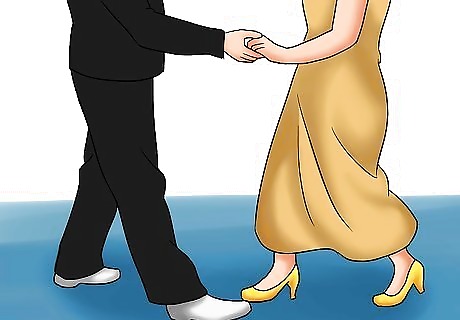
Add complex footwork. When two experienced bachata dancers dance with each other, they're unlikely to be content with the basic "left, right, front, back" steps for long. As you grow as a bachata dancer, for added challenge and entertainment, you'll probably want to start throwing new, more complex footwork patterns into your repertoire. Here are just a few ideas you may want to practice: Heel steps. Typically, on the fourth beat of each measure, you'll raise your foot slightly and roll your hips to the side. Instead, try kicking your foot out slightly so that its heel touches the ground and its toes are raised. You may need to bend your knees slightly to do this comfortably. The end result should be somewhat subtle - not an exaggerated "Cossack dance" kick, but slight variation on your normal step. Twisting. Instead of stepping back and forth, spend a measure twisting with your partner. Bend your knees slightly more than usual, then twist your hips and legs side to side to the beat of the music. Try varying between twisting twice per measure (once every two beats) and twisting four times per measure (once every beat). Leg-crosses. This move incorporates several kicks followed by a quick turn for a dazzling effect. Step to the side as you normally would for three beats. On beat 4, raise your leg slightly more than normal in preparation for a kick. On beat 1, keeping your upper body upright, gently kick out in front of you. Your leg should swing back on beat 2. Kick out again on beat 3, then, on beat four, cross your kicking leg across your stationary leg and plant it on the ground. Use your momentum to complete a full turn on beats 1, 2, and 3 of the next measure so that you're back in your "normal" position on beat 4.












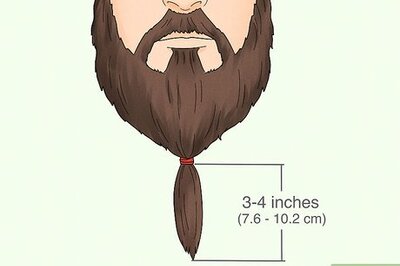



Comments
0 comment